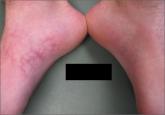A 14-year-old African American girl was brought to our clinic because she’d had a rash for 2 weeks. The girl’s mother reported that the rash had started as light red macules on her daughter’s arms that darkened overnight and disappeared slowly. The patient’s only complaint was that the rash burned. She denied using alcohol, tobacco, or illicit drugs. She’d had no recent illnesses, although she had recently begun taking amlodipine 10 mg for hypertension.
A physical examination revealed multiple dark circular macules with well-defined borders on the girl’s forearm (FIGURE). Concerned that the rash was an allergic reaction to the amlodipine she’d recently begun taking, we switched her prescription to lisinopril 20 mg.
Despite the switch to lisinopril, the patient had new lesions a week later at follow-up. The rash appeared as 5×5 cm erythematous macules in different stages of healing with central clearing. The girl said the lesions were painful to the touch and burned continuously, but did not itch. We referred her to a local dermatologist, who took biopsies of the lesions and referred her to a regional dermatology clinic.
Two months later, before visiting the regional dermatology clinic, the patient returned to our office. The lesions, which were now mainly 5-cm ovals with overlying blisters, had spread to the patient’s stomach and thighs. They were in various stages of healing, with one 7-cm bullous lesion located on the left arm. The patient said that other than the constant burning, she had no symptoms.
